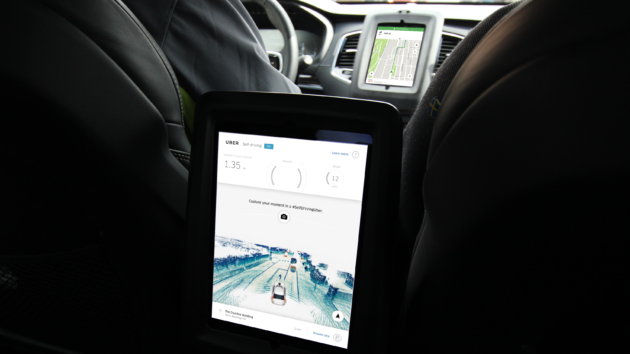
PITTSBURGH — Our first self-driving car experience was going great. And then we hit a pothole.
We were riding in Uber’s Volvo XC90 SUV, one of 200 self-driving cars operated by Uber in this city, as it made its way down Liberty Avenue on a chilly February morning. That’s when we ran over one of Pittsburgh’s infamous potholes just before a yellow light, jarring the steering wheel and causing the car to revert to manual driving mode. Thankfully, each autonomous ride has someone in the driver’s seat, just in case. Our Uber operator took over and slammed the brakes.
My smartphone went flying under the seat in front of me. I looked over at my colleague John Cook, and we were both shocked. But that wasn’t the end of it. A few minutes later, the car refused to enter self-driving mode and our operator had to drive us back to Uber’s facility for the final stretch.
It’s going to be a while before self-driving cars become the norm.
As part of our ongoing GeekWire HQ2 coverage this month, we visited Uber’s 80,000 square-foot self-driving engineering office in Pittsburgh, where the company first launched its Advanced Technologies Group three years ago after poaching around 50 people from Carnegie Mellon University.
RELATED: We rode in Uber’s self-driving car, and now we’re less confident in the future of autonomous vehicles
The tech giant has expanded ATG to three additional cities, with 1,500 people overall, but does the bulk of the software development work in Pittsburgh, a former industrial hub that turned into a center for robotics and autonomous vehicle research. Uber has 12 buildings across the city, plus a big test track for its self-driving technology.
Uber began offering rides in self-driving cars to Pittsburgh customers in 2016 and expanded to the Phoenix area last year. The company has completed 50,000 rides as of December, up from 30,000 in September. It is continuing to operate and expand in the city, despite a complicated relationship with Pittsburgh leaders.
Pittsburgh is one of the most difficult cities for a robotic vehicle to navigate. That’s partly why Uber planted its flag here. If a self-driving car can master Pittsburgh’s unorthodox street grid — featuring big hills, 446 bridges, narrow one-way corridors, ice, snow, and a pothole problem — it can drive pretty much anywhere.

We took our first autonomous trip this week in Pittsburgh, and it was a fascinating experience. Uber’s tech-laced vehicle constantly scans its environment, detecting everything from pedestrians, traffic lights, and signage. It automatically drops its speed in school zones and knows when a bicyclist is approaching from behind. There are gadgets everywhere, from the spinning LIDAR units above to the powerful onboard computer in the trunk.
It’s both magical and weird to watch the steering wheel turn on its own as the car rounds a corner.
But most of the excitement I had for these futuristic vehicles has been replaced by wariness — for now, at least.

Aside from the pothole incident, our ride was often jolty as the car adjusted speed. It felt like a 16-year-old cub driver was at the wheel. As time went on, I became more nervous about trusting a computer to understand the nuances of navigating a city with unpredictable humans, weather, and other variables.
Our 20-minute test ride didn’t last long enough to encounter every traffic scenario, but based on what we saw, I couldn’t help but doubt the car’s ability to navigate tricky situations.
Inside Uber’s office in a converted Pittsburgh Restaurant Depot, we saw the company’s next generation of self-driving cars, which won’t require a human operator in the front seat. No, thanks. There’s no way I’m letting a robot drive me around without human backup, at least not until the technology improves.

There are a ton of technical challenges to be solved. Bryan Salesky, CEO of Argo AI — a well-funded self-driving startup based near Uber in Pittsburgh — explained in this blog post that the industry is “still very much in the early days of making self-driving cars a reality.”
“Those who think fully self-driving vehicles will be ubiquitous on city streets months from now or even in a few years are not well connected to the state of the art or committed to the safe deployment of the technology,” he wrote. “For those of us who have been working on the technology for a long time, we’re going to tell you the issue is still really hard, as the systems are as complex as ever.”
There are also big questions about security and privacy. Uber and other companies can collect a ton of data on a city’s pedestrian or traffic activity, for example — what should they be sharing? Potential hacking of these moving machines is a concern, too.

Uber CEO Dara Khosrowshahi, who took the helm at Uber last summer, said last month that he thinks the company will have autonomous cars on the road “not as a test case but as a real case” within 18 months. But he thinks it will take 10-to-15 years before Uber’s autonomous vehicles become ubiquitous. The company is also developing self-driving semi trucks.
It’s going to be incredibly difficult for tech giants like Uber and Alphabet’s Waymo — which are currently embroiled in a blockbuster trial — to earn the trust of consumers. However, the amount of investment going into these projects indicates that self-driving cars could eventually go mainstream.
At a recruiting event at Carnegie Mellon University last week, Uber told students that its mission with self-driving vehicles is to save lives, time, and space. That bold vision for the future is exciting. It’s just going take more time than many people think.



